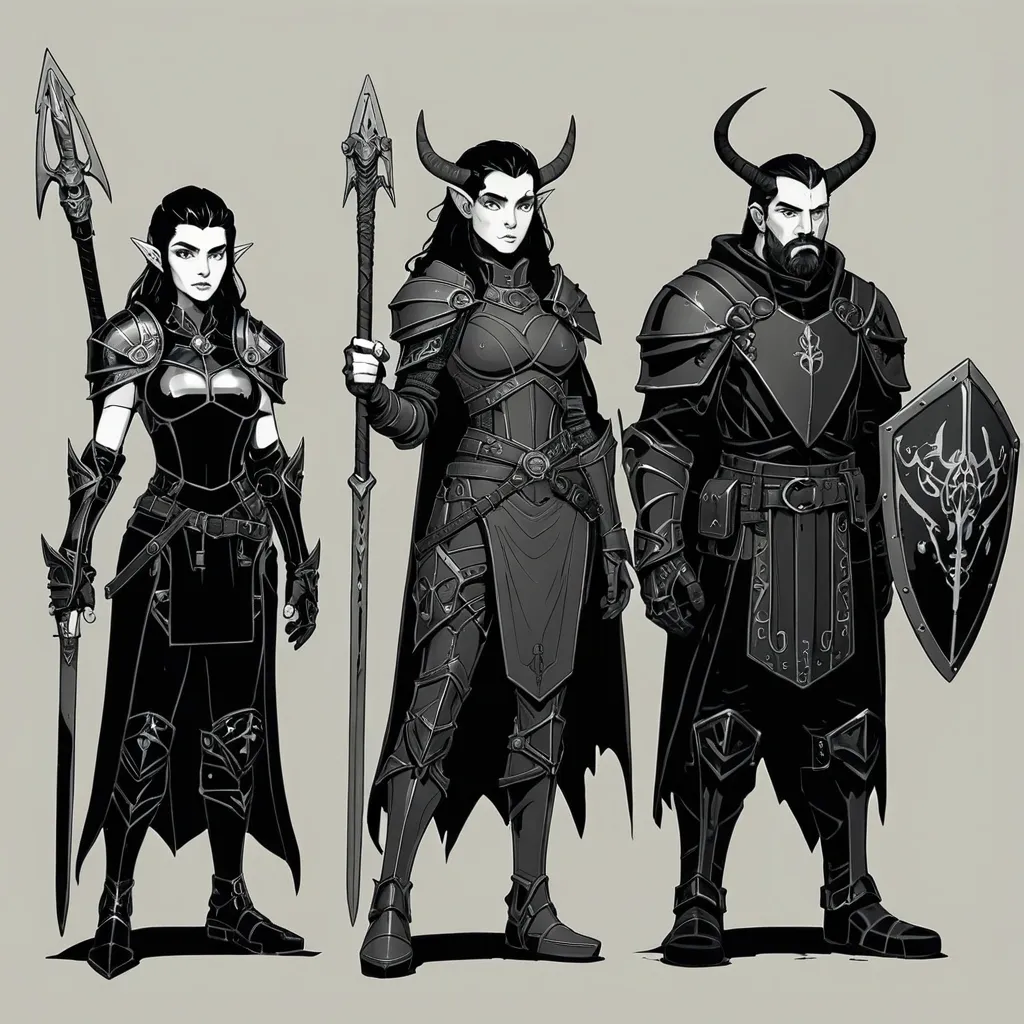AI Image Prompts for Rey
Explore AI generated designs, images, art and prompts by top community artists and designers.

Generate Gorgeous female boss , bimbo , hourglass body , abnormally massive female bodybuilder , gorgeous , close up , full lips , big booty , redheaded , freckles on face and breast , braided design hair , feminine silhouette , too big breast , big booty , sexy thighs abs , silhouette , up close , flexing biceps , beautiful green eyes , legs are iconic and defining physical feature , both visually and in terms of combat ability.wearing an outfit that is a striking blend of elegance , power , and femininity , designed to command attention in any room. The suit is tailored to perfection , hugging the wearer’s curves with precision while emphasizing a structured silhouette. The fabric itself is a refined grey tweed patterned with subtle white grid lines , giving the suit a texture that feels both sophisticated and modern. The blazer features broad blue lapels and gold button accents , adding a luxurious touch that elevates the look beyond typical business attire. The matching high-waisted trousers elongate the frame , further enhancing the poised and commanding effect of the ensemble.The styling choices amplify the boldness of the suit. The inner blouse is a silky , greybutton-down shirt that complements the tweed’s tone while introducing a softer , feminine balance to the sharp tailoring of the jacket. The blouse peeks out neatly from under the blazer , maintaining elegance without drawing focus away from the suit’s commanding cut. Accessories are kept minimal yet intentional: a delicate layered gold necklace and hoop earrings that add glimmers of light and luxury without overpowering the outfit. The choice of voluminous , honey-brown braids cascading down her shoulders frames the face with both confidence and glamour , completing the commanding visual.Altogether , this look communicates a blend of authority and allure. It is business-ready yet fashion-forward , balancing corporate structure with vibrant femininity. The color palette blue , grey and gold avoids being overly delicate , instead embracing the richness of texture , structure , and presence. This is the kind of ensemble that speaks to ambition , sophistication , and personal style—ideal for someone who thrives in positions of influence but insists on expressing her individuality with bold elegance. It’s not just clothing—it’s a statement of power wrapped in grace. In luxury living legs that could crush a watermelon , skirt high boots are a bold and striking statement piece , crafted in glossy black patent leather that gives them a sleek , polished finish. Rising to just below the knee , the boots feature three adjustable buckle straps along the shaft , adding both edge and detail to their design. The towering stiletto heel , paired with a thick platform sole , creates an ultra-dramatic silhouette that elongates the leg and exudes power and confidence. With their combination of shine , height , and structure , these boots perfectly balance fierce femininity with high-fashion allure. Generate Gorgeous female boss , bimbo , hourglass body , abnormally massive female bodybuilder , gorgeous , close up , full lips , big booty , redheaded , freckles on face and breast , braided design hair , feminine silhouette , too big breast , big booty , sexy thighs abs , silhouette , up close , flexing biceps , beautiful green eyes , legs are iconic and defining physical feature , both visually and in terms of combat ability.wearing an outfit that is a striking blend of elegance , power , and femininity , designed to command attention in any room. The suit is tailored to perfection , hugging the wearer’s curves with precision while emphasizing a structured silhouette. The fabric itself is a refined grey tweed patterned with subtle white grid lines , giving the suit a texture that feels both sophisticated and modern. The blazer features broad blue lapels and gold button accents , adding a luxurious touch that elevates the look beyond typical business attire. The matching high-waisted trousers elongate the frame , further enhancing the poised and commanding effect of the ensemble.The styling choices amplify the boldness of the suit. The inner blouse is a silky , greybutton-down shirt that complements the tweed’s tone while introducing a softer , feminine balance to the sharp tailoring of the jacket. The blouse peeks out neatly from under the blazer , maintaining elegance without drawing focus away from the suit’s commanding cut. Accessories are kept minimal yet intentional: a delicate layered gold necklace and hoop earrings that add glimmers of light and luxury without overpowering the outfit. The choice of voluminous , honey-brown braids cascading down her shoulders frames the face with both confidence and glamour , completing the commanding visual.Altogether , this look communicates a blend of authority and allure. It is business-ready yet fashion-forward , balancing corporate structure with vibrant femininity. The color palette blue , grey and gold avoids being overly delicate , instead embracing the richness of texture , structure , and presence. This is the kind of ensemble that speaks to ambition , sophistication , and personal style—ideal for someone who thrives in positions of influence but insists on expressing her individuality with bold elegance. It’s not just clothing—it’s a statement of power wrapped in grace. In luxury living legs that could crush a watermelon , skirt high boots are a bold and striking statement piece , crafted in glossy black patent leather that gives them a sleek , polished finish. Rising to just below the knee , the boots feature three adjustable buckle straps along the shaft , adding both edge and detail to their design. The towering stiletto heel , paired with a thick platform sole , creates an ultra-dramatic silhouette that elongates the leg and exudes power and confidence. With their combination of shine , height , and structure , these boots perfectly balance fierce femininity with high-fashion allure. her Arms are held close to her body , under her chest at supporting her enormous breast , arms folded under enormous breast , massive chest , ,

Lonely lighthouse in endless fog and heavy seas , colorful fractal plasma energy vortex. a pulling Prism Assemblage Encapsulated within shaped of sailboat with torn sails shrouded in mist navigating in the middle of stormy turquoise ocean. The most striking element is the sky . Thick , billowing clouds stretch across the sky , heavy and textured with tones of grey , brown , and hints of blue. ,

Inkpunk sketchy vectorline style , double glitchy gradient , DSLR , grainy noisy interference banding , Oniric Shadow Weave photorealistic oil painting , world of a dark weaver , by Edward Gorey and Junko Mizuno , multiple facial piercings , repetitive hand-drawn art style , spiderweb patterns repeating into infinity , glowing black and silver , modern art style painting , by Jenny Saville and Francis Bacon , piercing , repetitive hand-drawn art style , silk thread repeating into infinity , glowing charcoal and platinum , art done by Suehiro Maruo , oil painting security camera , dark violet and lime green , inverted color cycling , hue-shift strobing , a Leonora Carrington surreal psychedelic painting security camera footage , pure manipulation shown in the haunted loom , weaver of nightmares , anaglyph chromashift glitches , game camera , posted on Friendster 2004. ar-9:16 ,

À giant muscular chubby most busty femalebodybuilder , housewife woman BBW musclée , heavy weight bodybuildeuse géante et plantureuse with giant chest , imposante dame massive , beautiful make up Maria Carey face , in a night club corridor , avec de gros seins , énormes biceps musclés , in black laces transparent very short mini loose nightgown with heels , exposant les seins , bras musclés exposés , dominante , jambes massives exposées , agressive , ,

Full body character lineup of the fantasy party standing side-by-side for scale comparison: 1. Bran (Short Stout Dwarf , holding Massive Rectangular Tower Shield) far left. 2. Elisa (Curvy Human Cleric , fitted half-plate , Heater Shield) middle left. 3. Aidan (Tall Black Commander , Broadsword on hip , NO shield) center. 4. Gerath (Tiefling Warlock , horns , Glaive-staff) middle right. 5. Lea (Slender Elf Scout , tight leather , Bow) far right. Plain grey background. Style: Angular Gothic Cartoon style , thick expressive black ink outlines , sharp geometric shapes , hard-edged cel-shading , flat colors , stylish dark fantasy comic book vibe , eye-catching attractive heroic art style , fantasy pin-up aesthetic , fantasy anatomy , Mike Mignola style mixed with Castlevania animation style , vector-like clarity , high contrast. --ar 16:9 ,

À giant muscular chubby femalebodybuilder , housewife woman BBW musclée , heavy weight bodybuildeuse géante et plantureuse with giant chest , imposante dame massive , beautiful make up Oprah Winfrey face , in a bedroom , avec de gros seins , énormes biceps musclés , in blue laces transparent very short mini loose nightgown with heels , exposant les seins , bras musclés exposés , dominante , jambes massives exposées , agressive , ,

an oil painting featuring a powerful female warrior in a dynamic pose. She has long , flowing black hair and a determined expression. Her skin is light , and she has striking facial features with bold makeup. The character is adorned in a metallic silver and red armor , with intricate designs and a prominent chest plate. Her arms are wrapped in black and red fabric , and she holds a large , imposing sword with a weathered blade. The background is concrete grey and blood red , enhancing the dramatic and intense atmosphere of the scene. The overall composition is bold and visually striking , emphasizing strength and confidence. ,

Image is an oil digital illustration featuring a powerful female warrior in a dynamic pose. She has long , flowing black hair and a determined expression. Her skin is light , and she has striking facial features with bold makeup. The character is adorned in a metallic silver and red armor , with intricate designs and a prominent chest plate. Her arms are wrapped in black and red fabric , and she holds a large , imposing sword with a weathered blade. The background is concrete grey and blood red , enhancing the dramatic and intense atmosphere of the scene. The overall composition is bold and visually striking , emphasizing strength and confidence. ,

À giant muscular chubby femalebodybuilder , housewife woman BBW musclée , heavy weight bodybuildeuse géante et plantureuse with giant chest , imposante dame massive , beautiful make up , Maria Carey face , in a train , avec de gros seins , énormes biceps musclés , in violet laces transparent short mini loose nightgown with heels , exposant les seins , bras musclés exposés , dominante , jambes massives exposées , agressive , ,

{ "prompt_type": "Cinematic Mixed Media Portrait" , "subject_details": { "main_subject": "indian mature man" , "clothing": "Loose blue Cheks-shirt , high-waisted jeans pants with white sketch-style outlines , chunky beige sneakers" , "pose": "Relaxing on a modern grey leather sofa , holding a tall iced coffee , smiling softly and looking to the left" , "companion_character": "Large Fictional Characters character Chhota Bheem with glasses , bright colors , exaggerated expressions , holding a red cup with a straw" } , "environment": { "setting": "Cozy coffee shop interior" , "furniture": "Modern grey sofa , warm wooden shelves with small decorative items" , "atmosphere": "Minimalist , modern , warm" } , "lighting_and_composition": { "lighting": "Soft natural lighting streaming in from the right" , "blending": "Cartoon character seamlessly blended with soft shadows" , "effects": "Subtle doodle-style white line highlights around the man and cartoon character" } , "technical_specs": { "resolution": "High-resolution , vibrant , clean composition" , "aspect_ratio": "3:4" } ,

Bird's eye view of sea wildlife with an giant eagle ray-fish forming a body-shaped cutout within a gentle pasture. A woman in a red dress is drowning , reaching upward while lying horizontally underwater , far in the background. Chains extend from her ankles toward the bottom. The surrounding underwater ocean waves landscape has soft waves merging into facial forms. Style is poetic surrealism with limited drops of water and warm grey and amber light. ,

aerial perspective , massive eagle ray fish morphing into a pastoral landscape , internal underwater scene with a woman in a crimson dress suspended horizontally , pale ghostly light revealing her chained ankles descending into shadowy oceanic depths , soft marine life blending with ethereal wave forms , poetic surrealist composition , warm grey color palette , subtle amber illumination , delicate water droplet accents , dreamlike underwater texture with organic boundary transitions , haunting sense of suspended movement --ar 16:9 --stylize 750 --chaos 35 ,

extreme close-up half-portrait of a young woman. Razor-sharp focus on her deeply contemplative eye. and long , wavey hair forming dramatic , harsh , volumetric window-light shadows (suggesting palm leaves or blinds) across her face. Her lips are parted slightly , soft , and natural. Her eyes are bright , cool blue with a hint of grey , slightly almond-shaped with naturally curled lashes and softly defined brows. Her nose is delicate and narrow with a softly rounded tip , clearly adorned with a small silver nose ring piercing on her left nostril , catching the light with a subtle metallic reflection. Her lips are full with natural fine lines , warm rose-brown in color , subtly highlighted by the flash. Her skin has a warm , sun-kissed bronze tone with visible freckles , natural pores , faint veins , and a subtle sheen that reflects the flash realistically. Her hair is deep brunette , long and wavy with curtain bangs , a few realistic flyaways framing her face , humidity-reactive strands catching light. The entire right side of the image , background and all , falls off into deep , creamy , dreamy bokeh blur , with extremely shallow depth of field and subject isolation. Arthouse movie-like , minimalist , profoundly melancholic , haunting atmosphere with subtle film grain and minimal vignette. ar-3:4 ,

Hyper-detailed , ultra-realistic illustration of an Tiger emerging from dense jungle foliage. The Tiger has glowing amber eyes , sharp intricate skin textures , and an intense forward gaze. Surrounding leaves are stylized in deep blacks and greys with bright orange accents that create a dramatic contrast. Close-up composition with the tiger partially hidden between the foliage. Cinematic lighting , high contrast shadows , surreal orange–black color palette , moody atmosphere , fantasy wildlife art , extremely sharp details , 8K quality. ,

Surrealism: Portrait of a Eagle ray whose body is a large mask-shaped cutout within a gentle pasture. Inside the mask , a women in a black dress laying horizontally underwater drowning and reaching for the top. The women should far away from the foreground. Add chains to her ankles going towards the bottom of the picture , and a pale underwater. The surrounding landscape is underwater of ocean , with soft waves merging naturally into the facial forms. Style: poetic surrealism , limited drops of water , warm grey , and amber light. ,

Extreme macro close-up , high contrast , low-key lighting portrait of a 48 years old Indian woman wearing a wide-brimmed cowboy hat with dark , slightly wet hair framing her face. She gazes forward , revealing blue eyes with winged eyeliner and rose eye-shadow. Vibrant blue , yellow , and red paint splatters adorn her face , left eye , nose , right shoulder , and chest. Her lips are bright red , skin smooth with a subtle sheen. A bright white orchid in her hair dripping with pink hints and washed ink mixed colors right. Paint also splatters the flower background is dark grey texture. Artistic , expressive , beauty and chaos. ,

À african giant muscular chubby femalebodybuilder , housewife woman BBW musclée , heavy weight bodybuildeuse géante et plantureuse with giant chest , imposante dame massive , beautiful make up , Maria Carey face , in a train , avec de gros seins , énormes biceps musclés , in violet laces transparent short mini loose nightgown with heels , exposant les seins , bras musclés exposés , dominante , jambes massives exposées , agressive , ,

*An ultra-minimalist , high-end logo for a Pilates and holistic wellness studio. The design consists solely of a single , symbolic icon—no text—centered on a pristine white background. The icon is a gracefully stylized human silhouette in a poised Pilates posture (e.g. , single-leg balance or controlled extension) , rendered with feather-light , fluid lines that evoke breath , flow , and mindful movement. Key detail: the foot is clearly elevated or delicately detached from the ground—creating intentional negative space between the sole and an implied floor—emphasizing lightness , recovery , and dynamic balance. The entire silhouette uses clean , ultra-thin line work (0.25–0.5 pt equivalent) , with subtle curvature and tapered ends , avoiding any heaviness or visual clutter. Color palette: a sophisticated harmony of muted moss green (#6B8E6B or similar) , warm ivory beige (#F5F0E6) , and soft graphite grey (#4A4A4A) , applied with high contrast but gentle tonal transitions. Use color sparingly—ideally one or two tones max—to maintain elegance and scalability. The overall aesthetic merges architectural precision with organic softness: think Japanese minimalism meets Scandinavian wellness design. It must feel serene , inclusive , and quietly powerful—conveying feminine energy without excluding any gender. Optimized for die-cut production , luxury merchandise (tote bags , ceramic mugs , apparel embroidery) , and large-format signage. Every curve must be vector-ready , with no fills—only delicate contours that breathe negative space.* ,

photoralistic full lenght , white and bronze sleeveless , openside dark-blue swimsuit , matching boots , shoulder wavy brown hair , white pale freckled 40yo beautiful woman with , a laser gun in right hand. an auburn female 22 in blue and grey matching swimsuit with backpack is standing beside her a bit upset , handing laser gun. They are in a futuristic M.C. Escher labyrinth cinematic style ,

extreme close-up half-portrait of a young woman. Razor-sharp focus on her deeply contemplative eye. and long , wavey hair forming dramatic , harsh , volumetric window-light shadows (suggesting palm leaves or blinds) across her face. Her lips are parted slightly , soft , and natural. Her eyes are bright , cool blue with a hint of grey , slightly almond-shaped with naturally curled lashes and softly defined brows. Her nose is delicate and narrow with a softly rounded tip , clearly adorned with a small silver nose ring piercing on her left nostril , catching the light with a subtle metallic reflection. Her lips are full with natural fine lines , warm rose-brown in color , subtly highlighted by the flash. Her skin has a warm , sun-kissed bronze tone with visible freckles , natural pores , faint veins , and a subtle sheen that reflects the flash realistically. Her hair is deep brunette , long and wavy with curtain bangs , a few realistic flyaways framing her face , humidity-reactive strands catching light. The entire right side of the image , background and all , falls off into deep , creamy , dreamy bokeh blur , with extremely shallow depth of field and subject isolation. Arthouse movie-like , minimalist , profoundly melancholic , haunting atmosphere with subtle film grain and minimal vignette. ar-3:4 ,

À african giant muscular chubby femalebodybuilder , housewife black woman BBW musclée , heavy weight bodybuildeuse géante et plantureuse with giant chest , imposante dame massive , beautiful make up Oprah Winfrey face , in a train , avec de gros seins , énormes biceps musclés , in red satin short mini nightgown with heels , exposant les seins , bras musclés exposés , dominante , jambes massives exposées , agressive , ,

Tower of London , 1550 CE , seen at eye level from the outer ward as massive grey stone walls and towers rise over the Thames; guards patrol the gate in cool dusk light , torches flickering against the fortress , Style: Matte Painting , detailed and atmospheric with subtle depth of field , Eye-level view , 4K. ,


African Maid woman BBW musclée , heavy weight bodybuildeuse géante et massive , imposante dame noire , Oprah Winfrey face , avec de gros seins , énormes biceps musclés , in white mini apron tablier sexy , exposant les seins , bras musclés exposés , dominante , jambes massives exposées , agressive , avec les poings serrés ,

A solitary figure , cloaked in shadow , stands on a desolate , windswept hill under a turbulent twilight sky. The air crackles with an unseen energy , reflecting the deep , resonant sorrow of hardship. Faintly illuminated by a distant , ethereal glow , the inscription "Nobody knows my troubles but God" hovers subtly in the mist. The scene is rendered in a somber , expressive abstract expressionist style , with heavy , visible impasto strokes and a muted , yet emotionally charged , color palette dominated by deep blues , greys , and touches of stark white. Inspired by the raw , emotional landscapes of Anselm Kiefer and the profound spiritual weight of Mark Rothko's color fields , this image evokes a sense of universal struggle and solitary faith. The lighting is dramatic and chiaroscuro , emphasizing the isolation and inner turmoil of the subject. A scene depicting profound hardship and faith , with a lone figure overwhelmed by "troubles so hard"; the lyrics "Nobody knows my troubles , but God" are subtly woven into the background. Expressed through a gritty , emotional realism reminiscent of Dorothea Lange's documentary photography and Käthe Kollwitz's expressive etchings. The lighting is stark and dramatic , with chiaroscuro elements emphasizing the figure's solitude and the weight of their burdens , rendered in a desaturated , monochromatic palette to heighten the sense of despair and spiritual resilience. ,

A surreal fountain sculpted as a sorrowful young woman , a lone figure embodying resilience , spews crimson liquid from a stone basin , creating a mesmerizing whirl as it cascades. A stylized , mystical bird with iridescent feathers and subtly luminescent eyes perches on the brim , its gaze fixed on the flowing liquid , against a blurred , shadowy landscape suggesting past struggles. The scene is rendered as a dark fantasy illustration with a gothic , dreamlike atmosphere , inspired by the macabre art of Zdzisław Beksiński and H.R. Giger. Dramatic chiaroscuro lighting , with stark highlights and deep shadows , emphasizes the tragic beauty and eternal longing , evoking the determined , defiant mood of Caravaggio and Francis Bacon. Moody , desaturated colors with vivid crimson , ethereal blues , and melancholic greys dominate the palette , highlighting the solitary struggle and unwavering resolve. ar-9:16 ,



